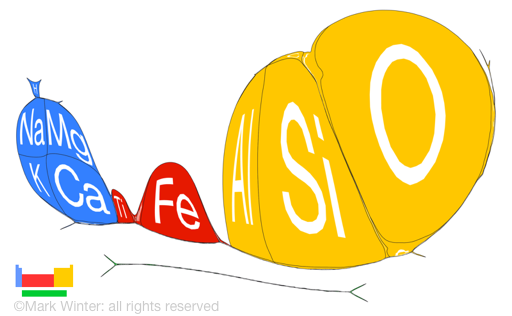Lithium - 3Li: geological information
Lithium does not occur as the free metal in nature because of its high reactivity. Deposits are known all aroun the world. It is a minor component of nearly all igneous rocks and is a component of many natural brines (see below). Large deposits are located in California and Nevada (both in the USA) in several rock forms, particularly spodumene. The four main lithium minerals are spodumene, lepidolite, petalite, and amblygonite.
- spodumene: LiAlSi2O6. This is the most important and abundant of the lithium ores. Deposits are located in North America, Brazil, USSR, Spain, parts of Africa, and Argentina. One method of extraction involves converting α-spodumene (the naturally occurring form) to the β-form (a less dense material) by heating to 1100°C, mixing with sulphuric acid, H2SO4, and heating to 250°C. This is followed by extracting into water to give a lithium sulphate solution, Li2SO4, suitable for further processing.
- lepidolite: K2Li3Al4Si7O21(OH,F)3. Deposits are located in Canada and parts of Africa. The mineral sometimes contains caesium and rubidium. Lithium can be extracted by similar methods to those of spodumene
- petalite: LiAlSi4O10. Deposits are located in parts of Africa and Sweden.
- amblygonite: LiAl(F,OH)PO)4. Amblygonite occurs in only minor deposits
Lithium is also recovered from lakes such as Searles Lake (California, USA) and Clayton Valley (Nevada, USA). Lithium is extracted from the brine by solar evaporation, precipitation of Group 2 elements if necessary, and precipiation of lithium carbonate by addition of sodium carbonate to the hot brine.
Abundances of lithium in various environments
In this table of abundances, values are given in units of ppb (parts per billion; 1 billion = 109), both in terms of weight and in terms of numbers of atoms. Values for abundances are difficult to determine with certainty, so all values should be treated with some caution, especially so for the less common elements. Local concentrations of any element can vary from those given here an orders of magnitude or so and values in various literature sources for less common elements do seem to vary considerably.
| Location | ppb by weight | ppb by atoms |
|---|---|---|
| Universe | 6 | 1 |
| Sun | 0.06 | 0.01 |
| Meteorite (carbonaceous) | 1700 | 4600 |
| Crustal rocks | 17000 | 50000 |
| Sea water | 180 | 160 |
| Stream | 3000 | 430 |
| Human | 30 | 27 |


The chart above shows the log of the abundance (on a parts per billion scale) of the elements by atom number in our sun. Notice the "sawtooth" effect where elements with even atomic numbers tend to be more strongly represented than those with odd atomic numbers. This shows up best using the "Bar chart" option on the chart.

